

2024-07-09
By Shanti Nelson

Growing up in the Pacific Northwest, John Featherstone has never minded the rain. In fact, having always felt a close affinity to the region’s waterways, it’s no surprise that he became the City of Shoreline’s Surface Water Manager. While he originally planned on pursuing a career in medicine, a job in his twenties as a CAD Technician introduced him to the world of civil engineering and surface water management. Excelling in his role, John knew immediately that engineering was the right field for him. Shortly after obtaining his Professional Engineer license, he began working for the City of Shoreline on their Surface Water programs and projects. He’s now been a member of the Shoreline team for ten years. John says, “It’s a great field which I love working in, but I had no idea as a teenager or twenty-something that this field even really existed, much less that it would be my chosen career field. But I’ve always loved rain, streams, and nature, and have always wanted to protect and restore the environment from human impacts.”
So, what exactly does John do as Shoreline's Surface Water Manager? He explains that when rain falls and lands on hard surfaces like roads, parking lots, and buildings, it becomes “stormwater”. In the city of Shoreline, stormwater flows through pipes and ditches into local waterways such streams, lakes, and the Puget Sound. It’s his responsibility to manage the runoff that flows into the City’s stormwater system, as well as manage the local waters that the stormwater drains into. John oversees a team of six individuals who manage key priorities such as inspecting both public and private stormwater systems, planning system improvements, providing public education, ensuring compliance with regulations, monitoring the water quality of local streams, responding to any reports of flooding, spills, or drainage issues.
John is currently hard at work updating the City of Shoreline’s Surface Water Master Plan (SWMP). He explains that the SWMP is updated about every six years, and serves a guiding document for all of the Surface Water work that is performed, how it is prioritized, and how it is funded. John and his team are currently halfway through the process, and have identified the specific items that will be prioritized throughout 2025 to 2030. He explains, “It is really exciting to plan for future improvements in our work, and our City is generally supportive of wanting to see us doing more, particularly in the area of adding more green stormwater infrastructure to better protect streams, prepare for climate changes, and increase the amount of “green” in the City overall. But it is a lot of work!”
Despite the hard work that goes into managing Shoreline’s surface water, John thoroughly enjoys his role: “I really love that my work is largely about protecting and improving our natural waters. It feels good to know that my work is helping make Shoreline, and the world, a better place. I really like getting to share my work with Shoreline’s residents (who are also my neighbors) and hear what matters most to them. It’s very satisfying to get to see the places in the city where I live where we have solved a stormwater problem or made things better in some other way.”
John highlights several ways that everyone can help make a difference and improve stormwater quality in their community, even if you don’t work in Surface Water Management. He shares, “It’s easy to think that if you’re not dumping pollutants down a storm drain, you’re not contributing to pollution.” However, many of the biggest culprits of stormwater pollution come from our routine daily activities. For example, everytime that we drive our cars, our tires leave behind particles on the roads that contain a chemical that is deadly to salmon when washed into streams. John says, “Obviously, people oftentimes have to get around and driving may be the only way to do so. But making choices to minimize unnecessary driving, such as walking, biking, taking mass transit, or simply staying home whenever you can makes a difference. Every little bit helps!”
Another large contributor to stormwater pollution is car-washing soaps, even ones marketed as “biodegradable.” When these soaps flow into the stormwater system, they eventually end up in our local streams, where they can be fatal to fish, amphibians, and other aquatic species. John says the solution is to be mindful about the ways in which you wash your car. Rather than washing your car on the street where harmful soaps can flow into stormwater drains, consider heading to your local professional car wash. Professional car washes are required to have special filtration systems that filter out potential pollutants from their runoff. When you choose to wash your car at a professional car wash, you can feel good knowing that you’re keeping your waterways healthy as well as supporting a small business. If you prefer to wash your car at home, John recommends pulling your vehicle onto your lawn. That way, the soapy runoff will drain into soil rather than flowing directly into a the stormwater system.
If you’re a Shoreline resident who wants to help keep your local waterways clean and marine wildlife protected, consider becoming a volunteer with the Salish Sea Stormwater Monitoring Project! Whether you’d prefer to take water samples from outfalls on the beach or conduct bacteria testing in the lab, there’s something available for everyone. No prior scientific experience is required, as the procedures are simple and easy to learn. If you have a few extra hours each month to spare, why not use your free time to help preserve our beautiful region? Email us at volunteer@stormwater-salishsea.org to learn more!
2023-12-22
By Shanti Nelson

Pat first began working for the City of Edmonds as a college student during his summer breaks. While he originally planned on becoming a teacher, working for the city was so rewarding that after graduation, he decided to stay. His first role in Public Works, which entailed stormwater system maintenance and pipe installation, equipped him with invaluable problem solving skills. Five years ago, Pat moved into his current role as Senior Stormwater Engineering Technician, where he’s helped his city make significant progress. “It’s really rewarding watching the city change in such positive ways,” he shares. “I love getting to be a part of that, whether it’s educating fellow community members or building new green infrastructure.”
It turns out that Pat did become a teacher after all, just not in the way he once imagined. L As the father of a fourteen year old, educating the next generation about environmental conservation is of the utmost importance to him. Pat shares that he doesn’t have to try very hard to sell his message to local students. “These kids care so much about the environment and want to help protect the orcas and fish,” he explains. “The teachers are already doing a great job educating the students on these topics. I just go in to tell them about what the city does and why we do it.”
“It’s great to see kids getting involved in conservation at such a young age,” Pat shares. The City of Edmonds provides financial support to Students Saving Salmon, a club created at a local high school. The students involved learn how to monitor local streams and creeks and conduct water quality sampling. The city of Edmonds also helps to buy the club supplies for their renewable fish program. Students learn how to raise fish from infancy, then release them into local streams.
Pat loves getting to work with students who are interested in pursuing careers in the environmental field. To those thinking about getting involved in the stormwater field, he advises, “Be ready for a lot of successes, but also be ready for some frustrations.” Pat explains that while his role is incredibly rewarding, making progress can take time and involve setbacks along the way. He shares, “When I first started out, I thought, ‘It’s gonna be 100% successful, I'm gonna change everything.’ But it’s a slow process to educate everyone, because we don’t all live in the stormwater world. Everyone has their own lives they’re dealing with, so it can be hard to get everyone on the same page.” When he’s confronted with challenges, whether it’s tracing where an illicit discharge is coming from or cleaning up a small oil spill, he relies on the problem-solving skills he learned at the very beginning of his career in the field installing stormwater pipes. Pat explains the importance of persisting, even if it takes many attempts to reach success. “When you finally do get it right, it’s unbelievably rewarding,” he shares.
As the one and only stormwater technician within Edmonds’ engineering department, Pat certainly has his hands full. Luckily, the volunteers from the Salish Sea Stormwater Monitoring Project have been able to lend a hand. Pat explains, “The volunteers are able to provide time and resources that I don’t have as a one-man team. When they first reached out to me, I thought, ‘This is fantastic!’” The volunteer team collects water samples from stormwater outfalls and tests them for pollution concentrations, bacteria, and heavy metals. Pat says that the volunteer’s work is “providing data that has been helpful to the city’s efforts.” When the volunteers discover an outfall containing above-threshold levels of an illicit discharge, they notify Pat who can find the root cause of the issue and eliminate it. He explains how rewarding it feels when water quality samples come back showing no harmful elements, as “that means our message is getting out and our citizens are doing their part.”
Pat shares several ways that all community members can do their part to improve water quality. Properly managing yard waste is one of the most important things you can do to make a difference. Pat urges folks to avoid blowing or sweeping leaves and yard debris into the street or sidewalk. These leaves clog up the drainage system and eventually break down. As they disintegrate, they release nitrogen and excessive nutrients into the stormwater. This phenomenon can dramatically affect the quality of the stormwater and the water bodies it flows into. When excessive nitrogen is present in water, it can create dangerous algae blooms. Algae blooms can suck the oxygen out of the water which is deadly to fish and other marine life.
23 different streams flow through Edmonds, many of which are fish-bearing. The water quality of streams is so vital that every Friday, the Edmonds Public Works Crew checks these watercourses to ensure they are free of clogging debris and visually check that high levels of pollution are not present. That’s why Pat helps those who live next to a stream to take extra precautions to care properly for the land. Living next to a stream means taking on a special responsibility, as one’s everyday actions have an impact on the health of the stream and the Puget Sound it flows into. Simple actions, like setting up a compost pile too close to the stream’s edge or dumping lawn clippings on the banks, can have a major impact on the stream’s water quality and the marine wildlife who call it home.
Learning how to best take care of our land and our waterways can be a challenge. That’s why Pat wants to help his community members by sharing his knowledge. He explains, “As I became a husband and a father, I became so much more aware of the importance of environmental conservation. My passion for the environment grew tenfold. Since I understand more now, I can make a difference by teaching others what I know.”
Want to learn more about how to make your home or business more stormwater friendly? Don’t hesitate to reach out to the City of Edmonds Stormwater Department. You can reach Pat at: pat.johnson@edmondswa.gov. Want to join our team of volunteers and help conduct water quality monitoring? Email us at volunteer@stormwater-salishsea.org!
2023-12-14
By Shanti Nelson
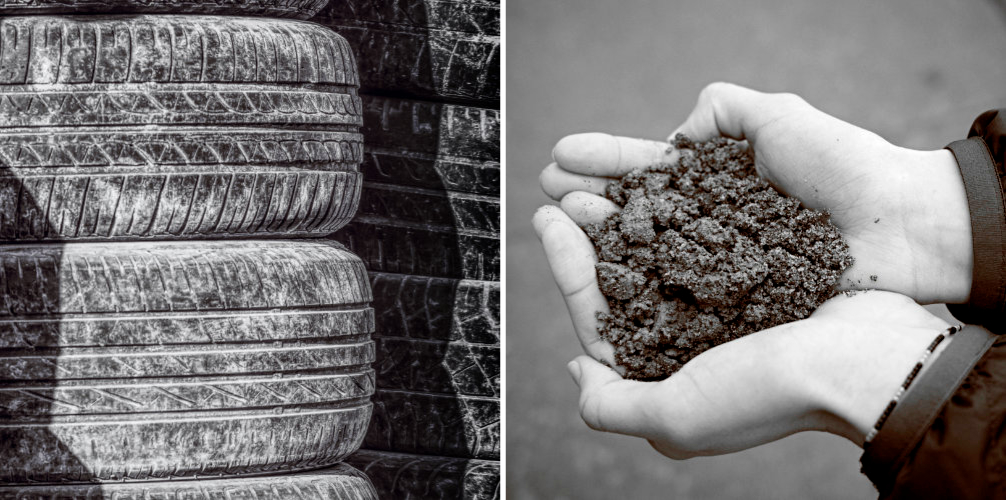
For over twenty years, environmental scientists battled a baffling mystery in the Pacific Northwest. Salmon who returned to urban streams and rivers in the Puget Sound were dying before they could lay their eggs. While the cause of their deaths was unknown, researchers hypothesize that toxic chemicals from roads and highways were to blame.
Identifying the culprit was of the utmost importance for scientists, as the salmon population plays a vital role in our local ecosystems. Salmon are the main food source of the endangered Southern Resident Orca Whales, whose population is the lowest it’s been in thirty years. Salmon are also linked with the culture of Indigenous communities, as well as the Washington State economy and food supply. This means that the health of the salmon population is closely intertwined with the prosperity of aquatic species as well as humankind.
University of Washington researchers made a breakthrough discovery in 2020 when they pinpointed the chemical culprit: 6PPD-quinone. 6PPD stands for the chemical N-(1,3-dimethylbutyl)-N'-phenyl-p-phenylenediamine. This chemical prevents tires from breaking down. When 6PPD is exposed to air, it reacts with ozone (a naturally occurring gas) to create 6PPD-quinone. Due to friction on the road, driving causes tires to release small particles, which contain this harmful chemical. After rainfall, this chemical eventually makes its way into nearby streams and rivers, where it has deadly impacts on salmon.
In order to address an issue as widespread as tire dust, Washington state organizations are working hard to find a solution. Since tires are the main source of 6PPD-quinone, the long-term goal is to prevent tires from releasing this toxic chemical. However, removing 6PPD from tires altogether without an effective replacement would be dangerous for both humans and the environment. The ingredient prevents tires from breaking down quickly, which keeps passengers safe. In addition, the ingredient minimizes the amount of tires in landfills, since it prolongs the tire’s life and defers it being thrown away.
Anacortes Stormwater Manager Diane Hennebert shared her insights on this multifaceted issue. She explained, “If I didn’t work in the stormwater world, my knee-jerk reaction would be, ‘This stuff is bad! We’ve got to stop putting it in tires immediately!’ But, there’s a lot more to think about. What kinds of impacts would it have on safety if tires had an incredibly short lifespan? How many more tires would be sent to the landfill after only being used for short time? What other options do we have and what impacts might those options have?”
Researchers are hard at work searching for safer alternatives. In November of 2021, the WA Dept. of Ecology published an assessment of nine possible alternatives to 6PPD Unfortunately, their research concluded that all nine proposed alternatives were either equally toxic to fish, cancer-causing to humans, or ineffective in keeping tires safely intact. Scientists continue to strive for the discovery of an alternative that would keep both salmon and roadways safe.
The WA Department of Ecology is also testing how to prevent stormwater from transporting 6PPD-quinone from rivers, streams, and the Puget Sound. The department has identified three major pillars in the fight to protect salmon:
The WA Dept. of Ecology continues to research the effectiveness of these methods, as well as meeting with local governments to incorporate these management practices into their infrastructure. The Department plans to release additional guidance in 2024 in order to assist local governments implement protective stormwater procedures.
Diane Hennebert explained more about how bioretention swales can be used to filter road water runoff. “A bioretention swale is a cross between a highly engineered rain garden and a drainage ditch,” she explained. “Swales consist of a gentle slope and a wide, flat bottom. A swale is designed to slow the water runoff down and allow it to infiltrate the soil, which will cleanse out the 6PPD-Quione compound from the water. The clean water will then be captured in an under-drain and channeled into the stormwater system.”
All drivers and vehicle owners can also take steps to be a part of the solution. Drivers can make an impact by inflating their tires at least every month, or when tire pressure gets low. Properly inflated tires will not shed as many tire particles that contain 6PPD-quinone, the chemical that is deadly to salmon. Click here to learn more about how to keep your tires properly inflated. A small task like inflating your tires has a significant impact on wildlife and your local community.
Want to learn more about the effects of tires on our environment? Check out these sources!
2023-12-05
By Shanti Nelson
Those who live in the Pacific Northwest are so lucky to consider it home. Surrounded by evergreen forests and stunning seascapes, it’s no wonder locals and visitors alike have fallen in love with the region. For Anacortes Stormwater Inspector Aaron Esterholt, helping residents preserve the natural beauty of their community is the ultimate goal. “It doesn’t matter where you are on the political spectrum, “ Aaron shares. “If you live here, it’s for a reason. It’s because you enjoy the outdoors, you enjoy the water, you enjoy fishing. Everyone plays a role in protecting our environment and preserving the nature we all enjoy.”

Growing up on his family’s ranch in Wyoming, Aaron’s passion for conservation was sparked at an early age. His grandfather often told him, “I might own the property, but this isn’t mine. This is nature’s gift to us.” This sense of stewardship and respect of nature has guided Aaron throughout his life and career.
After high school, Aaron served in the United States Army for 15 years. Afterwards, he worked for a sustainable timber company based in Tacoma. In that role, he learned how to balance consumption and conservation in order to preserve our forests. He gained even more experience while working for an environmental consulting company in Seattle, then worked for the City of Bothell’s Stormwater Department for over ten years.
In March of 2023, Aaron began his current role as Anacortes’ Stormwater Inspector, where he’s already made great strides. His main goal is to help local businesses become more eco-friendly and improve their practices when it comes to stormwater discharges. Aaron explains, “As a city worker, we work for the residents of Anacortes. Our job is to keep the place we call home safe and beautiful so that nature and wildlife can thrive.” Through his interactions with local business owners, he educates residents why caring for stormwater is so important. Many might not realize that their seemingly small actions, like dumping dirty mop water onto the sidewalk, may have major consequences. Anything that goes down the stormwater drain will flow directly to the Salish Sea without treatment, where it can negatively impact fish and other sea creatures.
Many residents and business owners are not yet aware of this reality. That’s where Aaron comes in. He approaches each interaction with the mindset of helping people learn, rather than making them feel reprimanded. “You don’t have to shame people or make them feel bad,” Aaron explains. “You just have to reach out, educate them, and help them change their habits.” Changing long-standing habits can be difficult, but Aaron ensures that he approaches the situation with compassion and understanding. He says, “If people knew, ‘Oh, this little thing I’m doing effects the place I love,’ it helps encourage them to change their habits.’”
Aaron reports that many local Anacortes businesses have enthusiastically made changes to make their practices more stormwater-friendly. “It’s so great to see when business owners take the information and really run with it,” he shares. Seeing residents and businesses making progress and doing their part to protect the environment is his favorite part of the job.
Aaron encourages anyone interested in conservation to pursue a career in the stormwater field. His biggest advice? “Be patient. You’ll want to come in and change the world and make big changes right away. But, it’s important to be patient with people and meet them where they’re at. It’s important not to lecture people and make them feel bad. If you listen to their concerns and explain how they can make new habits, you’ll have a lot more success.”
Aaron shares several ways we can all do our part to protect our marine waters. He cautions boaters against washing their boats directly in the water. Soaps, even those labeled “marine-safe”, contain elements that are harmful to the health of fish and other marine wildlife. When keeping your car or boat clean, it’s best to head to a professional car wash. Car washes have special filtration systems that separate chemicals out of runoff and keep these harmful pollutants out of the stormwater system. If you want to wash your car or boat at home, Aaron recommends pulling the vehicle onto your lawn. Any chemicals, bacteria, or solvents will drain into the soil rather than flowing down the road and directly into a stormwater drain.
With beautiful fall foliage comes leaf clean up. Aaron recommends caution when using a leaf-blower to clear leaves off your yard. When leaves are blown into the street, they often end up going down stormwater drains where they clog up the system as they decompose. Instead of blowing leaves into the street, make sure to keep them on your property. (Pro tip: when you leave leaves in your garden, nutrients are added to your soil which will help your plants grow bigger and stronger!)
Have questions about how to make your home or business more stormwater friendly? Don’t hesitate to reach out to the City of Anacortes’ Stormwater Department! You can reach Aaron at: aarone@cityofanacortes.org.
2023-10-23
By Shanti Nelson
It rains almost 200 days a year in the Pacific Northwest. One may wonder where all the water goes once it hits the ground. In Ancortes, WA, a network of drains and outfalls channel this stormwater directly into the Salish Sea. This water is left untreated before it flows into the ocean, putting wildlife like salmon and orcas at risk when the runoff is contaminated. Anacortes Stormwater Manager Diane Hennebert works tirelessly to protect local aquatic ecosystems. You’d be hard-pressed to find anyone else who loves their job quite as much as she does. Her enthusiastic personality and passion for the subject shines as she exclaims, “I just really love talking about stormwater!”
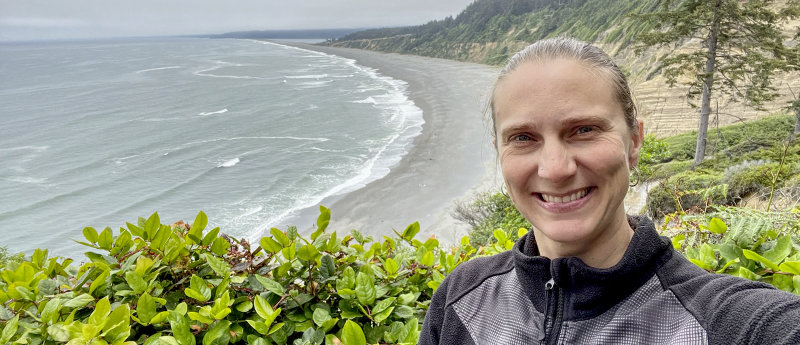
Diane explains that her passion for science and love of the outdoors began at a young age. She recounts growing up on the outskirts of Tacoma and playing in nearby drainage ditches as a child. She has fond memories of rescuing tadpoles in too- shallow water by carefully transporting them to deeper parts of the ditch. Her interactions with environmental infrastructure during early childhood made a lasting impression. She reflects on these beginnings, saying “Now I think, wow, that explains so much about my career path!”
Her work in marine conservation didn’t stop there. After high school, she spent a year working on environmental restoration through the Washington Conservation Corps. This inspired her to pursue a degree in Environmental Science at Humboldt State University in Northern California. She minored in Chemistry and placed her educational emphasis on Water Quality and Hazardous Waste, creating the educational foundation for the work she does today. She recounts that Humboldt, located between the Redwoods and the coast, was the perfect place to gain hands-on experience in her field.
Diane’s first job out of college involved stormwater treatment on construction sites in Shoreline, WA. She explains that muddy runoff from the construction sites would be pumped into processing tanks where the runoff would be treated using sand filtration systems. She recounts that water would come in with the appearance of chocolate milk, but would exit clean enough that it could safely be discharged directly to a salmon-bearing stream. This position propelled her to her next role as Stormwater Inspector for the city of Auburn, WA, where she was responsible for the routine inspection of privately owned storm drainage systems. Later on, while working for Pierce County’s surface water management program, she coordinated water quality sampling across the region. “It was a great job,” she tells me. “One day I might be sampling stormwater by the Port of Tacoma, and the next day I might be sampling a freshwater stream up by Mount Rainier.” Her drive to make a difference and abundance of professional experience has led her to where she is now, as the Anacortes Stormwater Manager.
Diane celebrates her five years as Stormwater Manager next month. Her hard work is driven by the opportunity to make an impact on our oceans and marine wildlife. “Stormwater is a very complex problem, with very real impacts on our aquatic ecosystems,” She emphasizes. “It feels good to do work that I feel has value and work on projects that make improvements for both my community and the Salish Sea.” Her responsibilities vary at any given time as each day brings with it new challenges and problems for her to solve. You might find her working with local businesses and contractors to improve stormwater practices, as well as focusing on community education and public outreach. You’ll also find her coordinating clean-up responses and investigating illicit discharges into the stormwater system, leading the charge on proactive environmental conservation. “I’m a really collaborative person,” she says. “That’s one of the things that I love about my job. I get to work across the entire city, and I get to work with a lot of other organizations.” She works in partnership with field crews on repairs and maintenance, with the legal department on amending city code, and with the Police and Fire Department on spill responses and pollution source investigations.
In addition to serving as the city’s Stormwater Manager, Diane represents Anacortes on the Skagit Marine Resources Committee. In collaboration with this team, she spearheaded a community project to construct a rain garden at Mount Erie Elementary School.
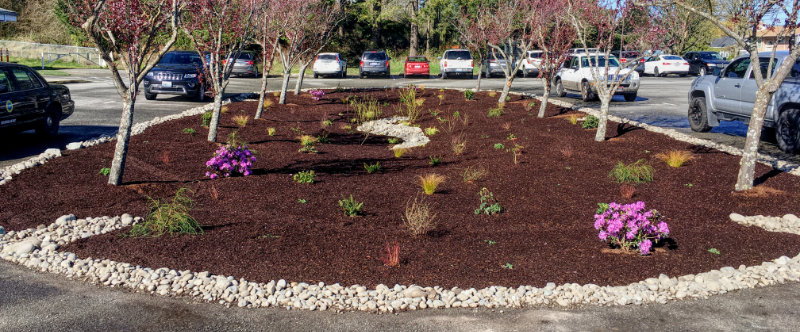
Partnered with the Skagit Watershed Council “Drain Rangers” Program, Diane went into the classroom to teach young students about stormwater solutions. She believes in the importance of educating children about marine conservation, and is excited to see what the next generation’s creative solutions to environmental issues will be.
Diane uses sampling data sourced from volunteers of the Salish Sea Stormwater Monitoring Project in order to combat water quality issues with precision and effectiveness. This data informs how she decides where to focus water quality efforts. “Through the hard work and close attention of the volunteers, we have been able to find some unauthorized discharges to the storm system and get them cleaned up.”
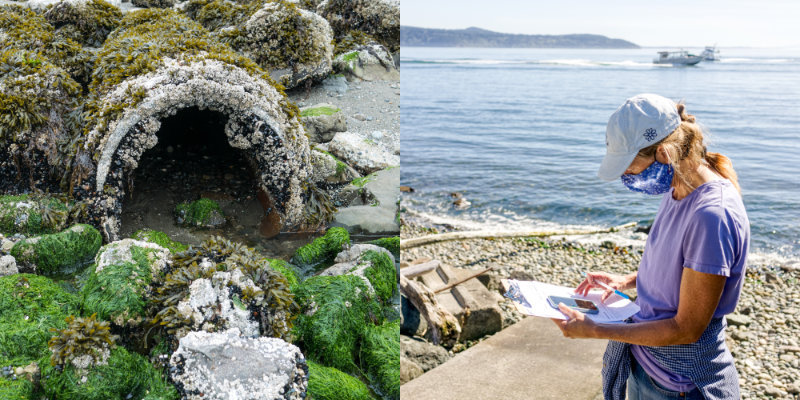
When volunteers found dangerously high levels of E. coli seeping from a city outfall last year, Diane launched a thorough investigation. She took samples from multiple locations that led to the drainage basin. The results of these samples allowed her to determine which neighborhood the high bacteria count was coming from. In order to locate the house that was responsible for the issue, she and her team utilized smoke testing. This method involves using a blower to send non-toxic smoke into the storm system through a manhole. This smoke exits out of anything that is connected to the storm system, narrowing down the possibly responsible locations. In this case, she noticed smoke coming out of a house’s sewer vent, which suggested that the home’s sewer was mistakenly connected to the storm drain rather than the sanitary sewer. After utilizing a dye test, which involves flushing a colored tablet down the toilet to see if the color appears in the stormwater outfall, she was able to confirm that the house’s system was indeed cross connected. The homeowner hired a contractor to properly connect the home to the sanitary sewer. The Salish Sea and the aquatic creatures who call it home are safer thanks to the collaborative effort of volunteers, Diane, and her hard-working team.
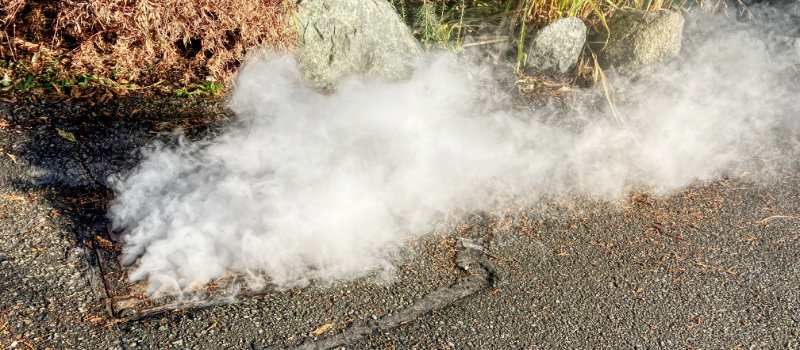
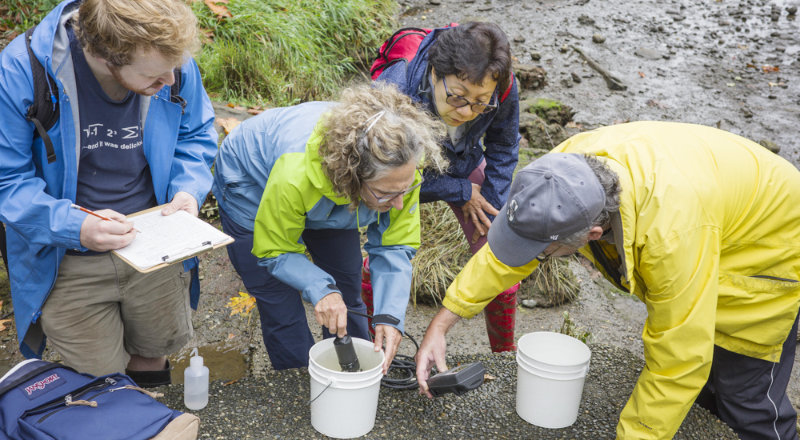
Diane encourages community members to take an active role by notifying the city if they spot possible water contamination or illegal dumping. Anacortes residents can reach the stormwater hotline at 360-293-1921.
They can also download the See-Click-Fix app, which allows users to report their concerns directly to the city. If you’re passionate about ocean conservation and have a few hours each month to spare, consider becoming a volunteer with the Salish Sea Stormwater Monitoring Project by reaching out to volunteer@stormwater-salishsea.org. You might make the next discovery that will aid Diane in her mission to keep our oceans clean.